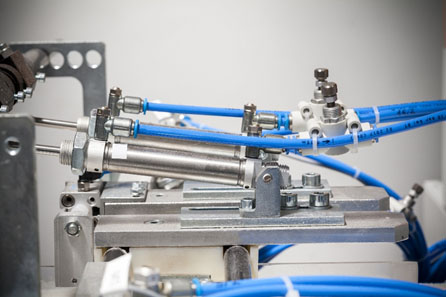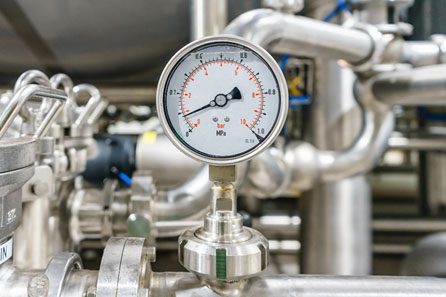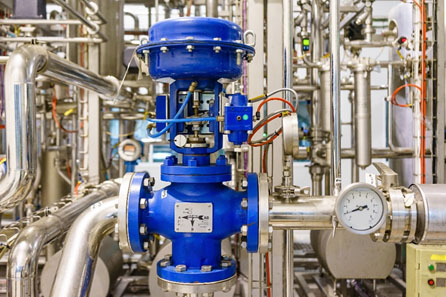Pneumatic system inefficiency: The problem you didn’t know you had
30/07/2018 10:54 am
Since the development of the first mechanical compressors at the dawn of the industrial revolution, the proven efficacy of pneumatic systems has established compressed air as the ‘fourth utility’ of manufacturing. And today, pneumatic systems are as critical to the manufacturing process as they have ever been.
Compressed air is the most reliable, safe and simple means of linear power transfer – in comparison to electric or hydraulic systems – which make them extremely popular in manufacturing facilities around the world.
However, most operators are unaware of the sometimes significant – yet easily correctable – inefficiencies that affect the overwhelming majority of pneumatic systems used in manufacturing.

Pneumatic systems are integral to modern manufacturing.
The cost of pneumatic inefficiency
In our experience, many manufacturers are not cognisant of the issues that compromise pneumatic system efficiency and are therefore unaware of their systems’ true operational costs.
In the average manufacturing plant, only half of the compressed air generated is consumed by the production processes for which it was intended.
It was also found that for every dollar spent on electricity being used to generate compressed air, an average of only 12 - 17 cents is being used productively.
However, with greater pneumatic system efficiency, utility costs can be greatly reduced. The U.S. Department of Energy found that improving pneumatic system efficiency can reduce electricity consumption by up to 50%.
But, very few operators in the manufacturing sector are fully aware of how inefficient their pneumatic systems are, and even fewer are aware of just how easy it is to rectify these problems.
With this in mind, we’ve compiled a list of the essential changes you can implement to maximise the efficiency of your pneumatic systems.

Most manufacturers are unaware of how inefficient their pneumatic systems are.
Enhance the performance of your pneumatic system by following these 3 steps
By implementing these steps, you can reap the benefits of a drastically reduced utility bill as well as a high performing, efficient pneumatic system:
1. Ensure your air is clean and dry
Compressors not only draw in air – they also inhale any nearby dirt, as well as a significant amount of moisture. And when those materials are deposited in the system’s pipes, it will be to the detriment of that systems efficiency.
Essentially, the build-up of corrosion and fouling “choke” the system, which reduces the flow of air through the pipes. That’s why it’s crucial to ensure your pneumatic system is as clean and dry as possible.
For many pneumatic instruments, this is a necessity for proper functionality. But even for end use components that don’t require clean air – like air driven tools or blow guns – keeping the air dry will help reduce utility costs.
The key to alleviating this problem is the correct installation of filters, aftercoolers, dryers and regulators. By ensuring these applications meet system requirements, your compressor will function more accurately and efficiently.
2. Reduce artificial demand
Artificial demand refers to the creation of excessively high air pressure through a pneumatic system, which causes air to be forced through leaks and other openings in the system. This means the system continues to run as though it needs to provide more air, despite the end components not being used – resulting in higher levels of inefficiency.
By reducing artificial demand, you can minimise the strain on air generation units, and simultaneously increase the lifespan of the unit whilst reducing exorbitant utility costs.
Working through a system to detect leaks is key to alleviating the costs of an inefficient system. By implementing instruments that keep your air at a constant pressure, you can ensure artificial demand and your utility costs remain as low as possible.
3. Reverse-engineer your pneumatic system design
Reverse engineering your pneumatic system from the point of demand is critical to designing a system that is ‘right-sized’ and operates at optimal efficiency.
By establishing the requirement from the ‘demand’ component first, you can work backwards to blueprint a design that is both highly dynamic and incredibly accurate. This process also allows for the:
- Correct sizing of pneumatic piping and connections. Limiting the variation in pipe and connection sizing, as well as, minimising the number of angle / elbow fittings significantly reduces pressure drop.
- Use of appropriately sized air treatment components. This also has a positive effect on pressure drop changes.
- Proper use of airflow regulators and dual pressure units. The correct positioning of actuators lowers air consumption, resulting in increased efficiency.
- Correct control and regulation of air consumption devices. Installing circuits to limit the use of air in high consumption devices (like diaphragm pumps and pneumatic motors) minimises energy depletion.
- Proper design and implementation of directional control valves. Using control valve technology that’s specific to the system requirements creates even greater energy savings.

Pneumatic efficiency can be greatly improved with some easy changes.
How to optimise the performance of your pneumatic system
Implementing these steps doesn’t have to be hard. At VFV, we have a team of pneumatic system experts who work hard to ensure you get tailored advice specific to your solution.
If you’re pneumatic system isn’t performing as efficiently as it should be, then get in touch with Paul La Roche on +61 3 9873 1400 or email at [email protected] to discuss implementing these steps in your own processes.
Or if pneumatic systems aren’t on your radar right now, but you’d like to find out more about current industry insights, check out last month’s blog on cutting down the costs and risks associated with corrosion.
Sources:
Jeangirard, P. (2017, April 18). 3 ways to prevent costly downtime in compressed air installations. Retrieved from, http://blog.parker.com/3-ways-to-prevent-costly-downtime-in-compressed-air-installations.
U.S. Department of Energy. (2014). Assessment of the market for compressed air efficiency services. Retrieved from, https://www.energy.gov/sites/prod/files/2014/05/f16/newmarket5.pdf.
Paul La Roche
Jack Collins
posted on 15/12/2018 9:38 pmYou must be logged in to post a comment.
click here to log in


air mite
posted on 3/12/2019 7:41 pm